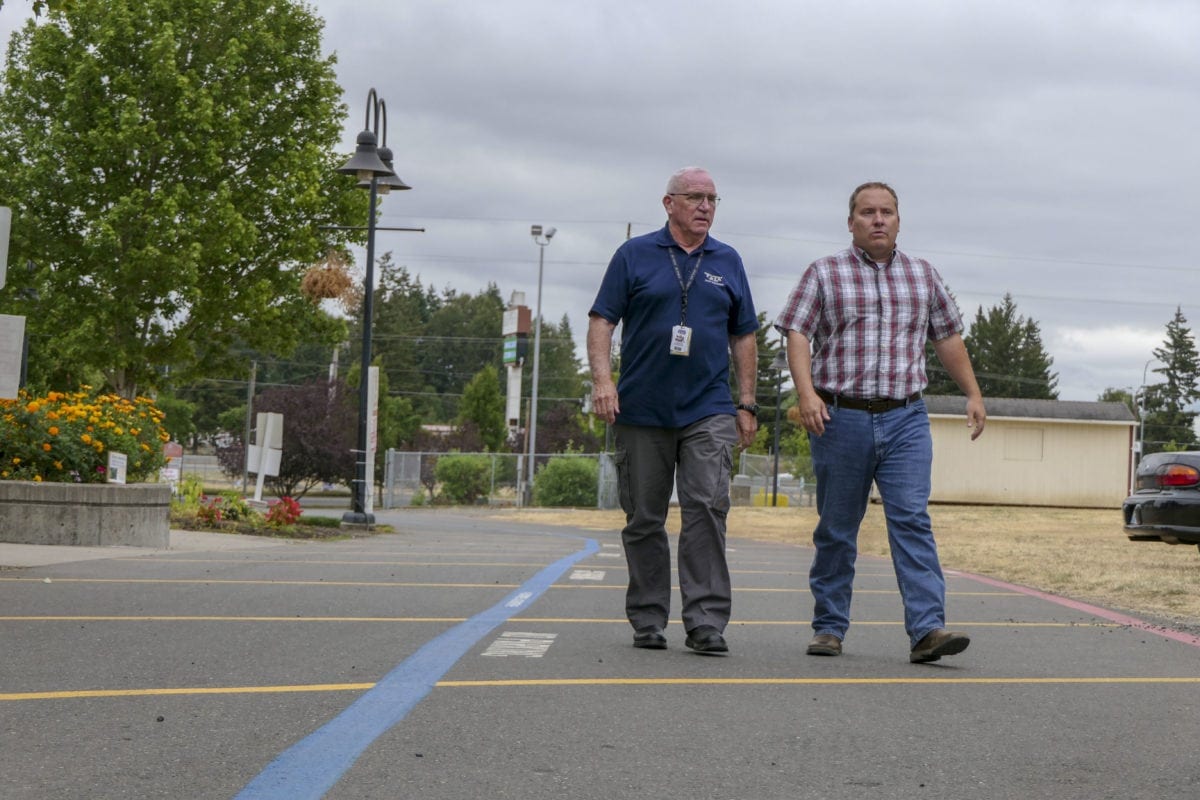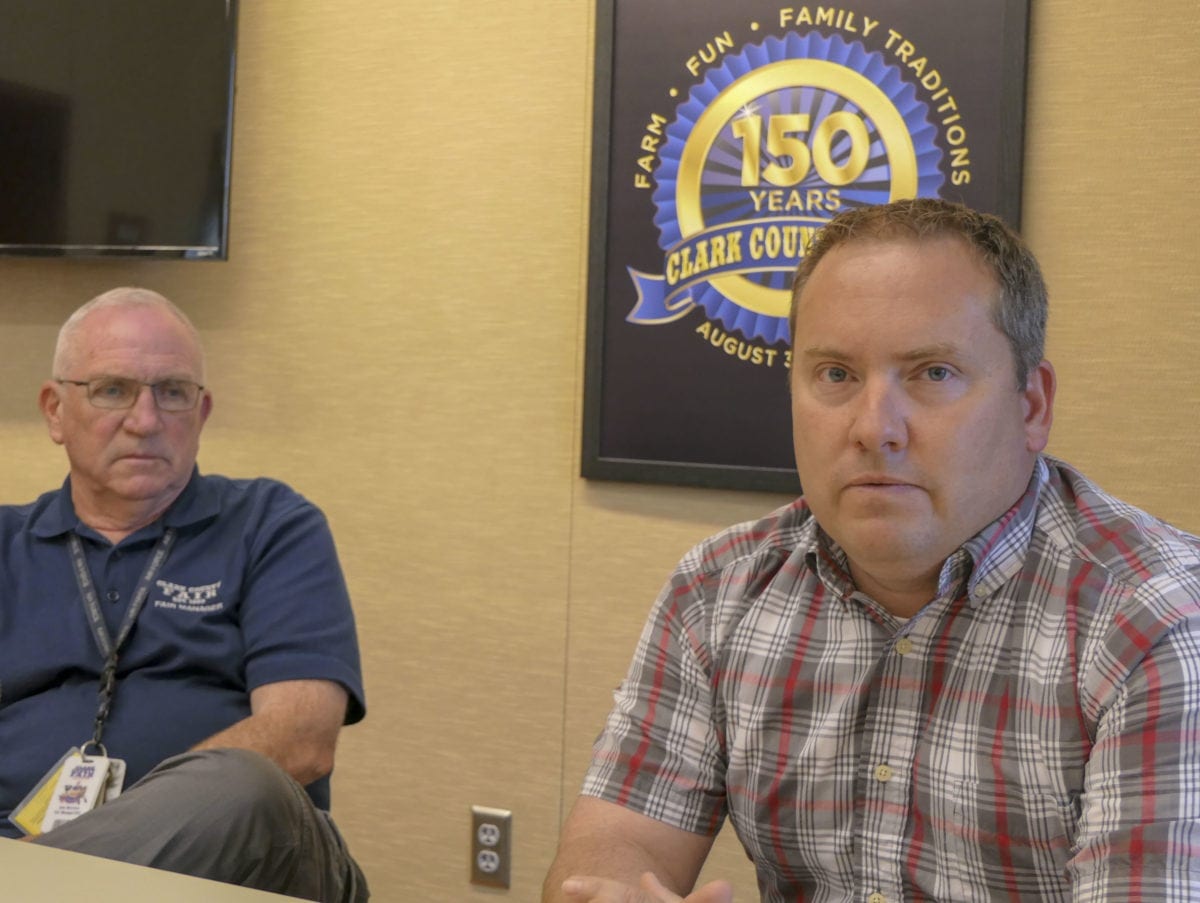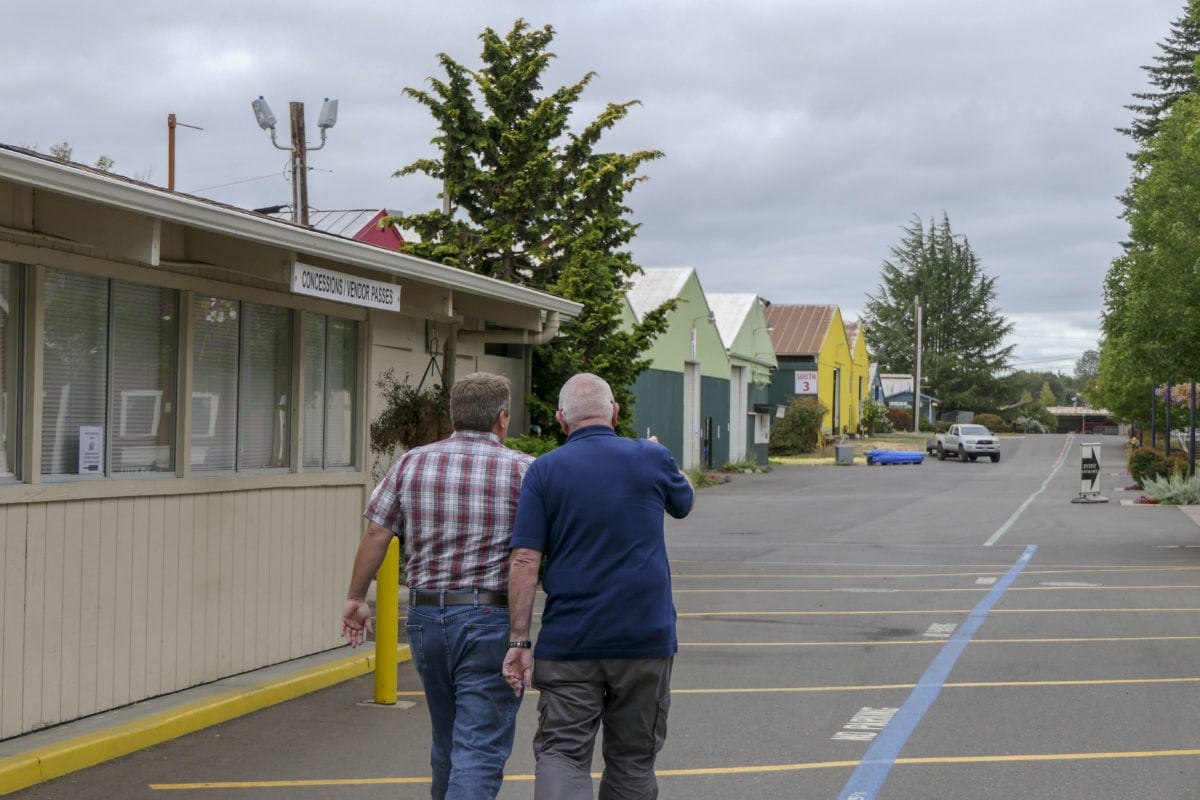Long-time director John Morrison is retiring, but plans to remain involved in the fair
RIDGEFIELD — The 150th Clark County Fair was the last for the man who has led it for nearly a decade. Retired Air Force Colonel John “Gator” Morrison will be stepping away from the fair director position, and 44-year old Mickey Webb, who grew up in Tennessee and spent 13 years in Baltimore, will take the reigns.

“I’m staying in the local area, so I don’t have any immediate plans,” Morrison says, grinning. “So I’m just going to take a little bit of a breather after this.”
“We’re not going to let him get away too far,” says Webb.
Morrison came to the fair nearly three decades ago, and says it got into his blood.
“This started out 27 years ago with a single frame of honey from a bee hive that I got as a hobby,” he says.
Morrison had to quit that hobby as an allergy to bee stings got worse, rather than better, but his wife is still actively involved in the community and that part of the fair.
“I don’t see her interest waning at all,” Morrison says, “and I don’t see my love of or interest in the fair waning either.”
What will change is the amount of time Morrison spends at the fair. During the 10 days the fair goes on, and for a couple days afterward, he could be found on the grounds pretty much 24-hours a day. He eventually took to parking an RV there for a place to sleep. It’s a practice Webb says he plans to continue.

Webb has a background in putting on events for colleges, agricultural expos, and more. He says it had been his goal since he was young to eventually end up in the Pacific Northwest.
“I think I’ve always equated it to the TV show MacGyver,” he says, “because it was always set in the Pacific Northwest. I just loved the look of it, so I’m like ‘OK, I’m gonna get out here’.”
Webb moved west in 2014 to take over as event coordinator and director at the Kittitas County Fair, and then Grant County in Moses Lake. He said his friendship with Morrison led to the decision to resign there and apply for the opening in Clark County.
“I’m here to take over the job, but I’m not his replacement,” Webb says of Morrison. “He’s done a lot of good things here, and I’m looking forward to continuing a lot of that.”
Before Morrison took over, the fair had been struggling to turn a profit, despite fairly strong attendance numbers. He says they’ve had to focus on cutting costs, and making sure they can appeal to modern families without losing the historical significance of the fair.
“When you’re dealing with an event that’s actually older than the state of Washington, you’ve got to recognize the history and the tradition,” Morrison says. “I have managed this fair with two main goals in mind, and one is the recognition of that history and tradition, which is to celebrate agriculture.”

Both Webb and Morrison acknowledge that the agricultural nature of Clark County is rapidly changing, as more land is developed and more people move here. Still, they believe the fair can keep people connected to their roots.
“There’s becoming a divorce between the people and their understanding of how the food system — how agriculture works,” says Webb. “And that’s one of the purposes I see of the county fair is to sort of reintroduce the community to things that they may not know… I didn’t know a sloth had three stomachs until I went through the 4-H educational exhibit.”
“I’ve had to… I won’t say struggle with, but I’ve had to keep my mind focused on ‘this is an agricultural endeavor out here’,” Morrison adds, “but then by the same token I’ve looked at keeping it relevant. What was interesting to youth in 1920, is probably not interesting to youth today.”
But just keeping kids interested in attending the county fair wasn’t enough to bring it back to profitability. Morrison believes the decision made under his leadership that made the biggest difference to the fair’s bottom line was to move the music performances out of the amphitheater and back into the grandstands.
“The concerts in the amphitheater tended to be higher paid acts, so the ticket prices were in the $60-80 range,” Morrison says. “And I don’t think the average fair goer was interested in spending $160 for a concert and then coming over here and spending anything at all.”
He says moving concerts back into the fairgrounds, and making most of the seats free, encouraged people to spend more in other areas of the fair. In the final year concerts were in the amphitheatre, Morrison says their profit and loss statement was about $94,000 to the good.
“In the years since we moved them back here, it’s about $440,000 to the good,” he says. “It’s literally that big.”
Morrison says his mantra has been that the price of getting into the fair should include most of your entertainment. “Unless you ride it or eat it”, it’s included, he says.
“There are fairs out there that have a five dollar gate, and they say ‘well how can you be at $11? How do you even extract that?’” he says. “Well when you get to that fair… ‘I want to see monster trucks.’ Oh, well that’s $16.”
While the fairgrounds have evolved significantly over the past decade-and-a-half, Webb says he sees added room for improvement.
“When I walk the grounds I see a lot of opportunity for some maintenance, some upgrades, and some re-layout,” he says. “The congestion of the fair, trying to alleviate some of that.”
The opening of the Clark County Event Center building in 2004 marked the biggest change the fair had seen since moving to its current location.
“This building was actually phase one of a pretty aggressive master plan to upgrade the entire fairgrounds,” says Morrison. “Obviously with the economy and budget struggles that people have, it’s going to be awhile before we get a second phase of that. But it would make a big difference out here.”
One thing that won’t change anytime soon is where the fair is located, and how big it is. While things may be growing around it, the fairgrounds are pretty much locked in.
“One of the reasons this fair is going to get better is that we can’t get bigger,” Morrison reasons.
The 150th iteration of the fair, by early measures, was a rousing success. Webb admits keeping the momentum going will likely be the biggest challenge he faces in his first full year as director.
“Next year’s fair will be the first of the next 150, because I do not see the fairs going away,” he says. “They are ingrained in the American culture. They’ve had their ups and downs as any industry has, but even in the tough years people still came to the fair.”
As for what they find there, don’t expect things to change drastically with Webb at the helm. Especially since he’ll likely have one volunteer with a lot more experience than he has, watching over his shoulder for a few more years yet.




